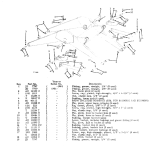LD1
Epic Contributor
Easy, the angle of the cylinder changed.
This was discussed in length about a month ago.
To find the force of a cylinder mounted on an angle, you multiply the total hydraulic force by the Sine of that angle.
So lets say at ground level the cylinder is at 30 degrees. Raise it may be like 10 degrees.
Sin30 = .5
sin10 = .17
So if the cylinder can straight-line push with 2000# of force, with that cylinder mounted on a:
30 degree angle, there is 2000 x 0.5= 1000# of LIFT force
10 degree angle, there is 2000 x 0.17 = 340# of LIFT force
See the difference?
This was discussed in length about a month ago.
To find the force of a cylinder mounted on an angle, you multiply the total hydraulic force by the Sine of that angle.
So lets say at ground level the cylinder is at 30 degrees. Raise it may be like 10 degrees.
Sin30 = .5
sin10 = .17
So if the cylinder can straight-line push with 2000# of force, with that cylinder mounted on a:
30 degree angle, there is 2000 x 0.5= 1000# of LIFT force
10 degree angle, there is 2000 x 0.17 = 340# of LIFT force
See the difference?


